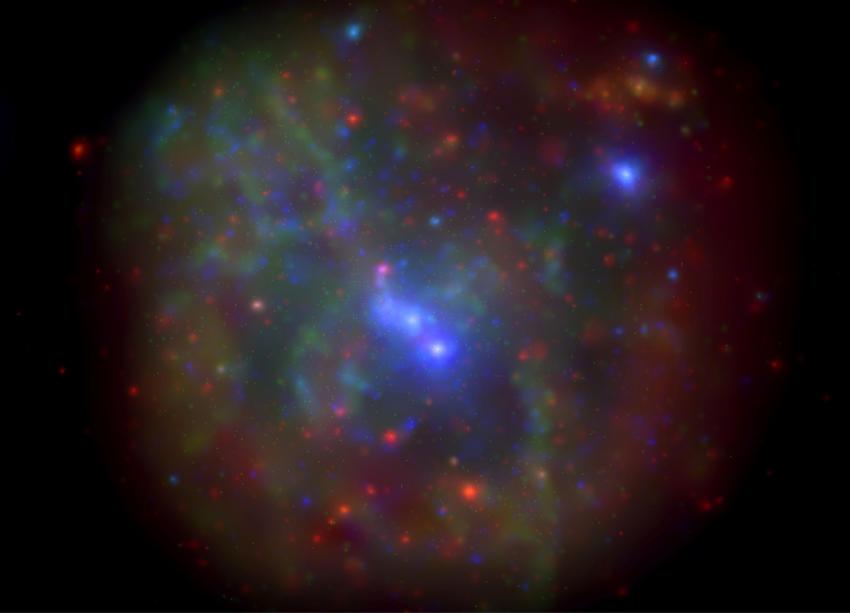An international team of researchers, led by postgraduate student Alexis Andrés, has found that the black hole at the centre of our galaxy, Sagittarius A*, not only flares irregularly from day to day but also in the long term. The team analysed 15 years’ worth of data to come to this conclusion. The research was initiated by Andres in 2019 when he was a summer student at the University of Amsterdam. In the years that followed, he continued his research, which is now to be published in Monthly Notices of the Royal Astronomical Society.
Sagittarius A* is a strong source of radio, X-rays and gamma rays (visible light is blocked by intervening gas and dust). Astronomers have known for decades that Sagittarius A* flashes every day, emitting bursts of radiation that are ten to a hundred times brighter than normal signals observed from the black hole.
To find out more about these mysterious flares, the team of astronomers, led by Andrés, searched for patterns in 15 years of data made available by NASA's Neil Gehrels Swift Observatory, an Earth-orbiting satellite dedicated to the detection of gamma-ray bursts. The Swift Observatory has been observing gamma rays from black hole since 2006. Analysis of the data showed high levels of activity from 2006 to 2008, with a sharp decline in activity for the next four years. After 2012, the frequency of flares increased again - the researchers had a difficult time distinguishing a pattern.
In the next few years, the team of astronomers expect to gather enough data to be able to rule out whether the variations in the flares from Sagittarius A* are due to passing gaseous clouds or stars, or whether something else can explain the irregular activity observed from our galaxy’s central black hole.
"The long dataset of the Swift observatory did not just happen by accident," says co-author and previous supervisor to Andrés, Dr Nathalie Degenaar, also at the University of Amsterdam. Her request for these specific measurements from the Swift satellite was granted while she was a PhD student. "Since then, I've been applying for more observing time regularly. It's a very special observing programme that allows us to conduct a lot of research."
Co-author Dr Jakob van den Eijnden, of the University of Oxford, comments on the team’s findings: "How the flares occur exactly remains unclear. It was previously thought that more flares follow after gaseous clouds or stars pass by the black hole, but there is no evidence for that yet. And we cannot yet confirm the hypothesis that the magnetic properties of the surrounding gas play a role either."
Media contacts
Dr Robert Massey
Royal Astronomical Society
Mob: +44 (0)7802 877 699
press@ras.ac.uk
Gurjeet Kahlon
Royal Astronomical Society
Mob: +44 (0)7802 877 700
press@ras.ac.uk
Science Contacts
Alexis Andrés
Institute of Astronomy, The National Autonomous University of Mexico
bandres@astro.unam.mx
Nathalie Degenaar
Anton Pannekoek Institute for Astronomy, University of Amsterdam, the Netherlands
N.D.Degenaar@uva.nl
Jakob van den Eijnden
Department of Physics, University of Oxford
jakob.vandeneijnden@st-hildas.ox.ac.uk
Further Information
The research appears in ‘A Swift study of long-term changes in the X-ray flaring properties of Sagittarius A*’, Monthly Notices of the Royal Astronomical Society, A. Andrés, J. van den Eijnden, N. Degenaar, P.A. Evans, K. Chatterjee, M. Reynolds, J.M. Miller, J. Kennea, R. Wijnands, S. Markoff, D. Altamirano, C.O. Heinke, A. Bahramian, G. Ponti, D. Haggard, 2022.
The research was led by Alexis Andrés from El Salvador. He participated in the summer of 2019 as an undergraduate student in the ASPIRE programme run by the Anton Pannekoek Institute of Astronomy at the University of Amsterdam. Andrés then returned to El Salvador and devoted himself to researching Sagittarius A*’s irregular signals for two years. He led the international research team from a distance due to the covid-19 pandemic. Andrés has been studying for a master's degree in astronomy in Mexico City since August 2021.
Notes for Editors
The Royal Astronomical Society (RAS), founded in 1820, encourages and promotes the study of astronomy, solar-system science, geophysics and closely related branches of science. The RAS organises scientific meetings, publishes international research and review journals, recognises outstanding achievements by the award of medals and prizes, maintains an extensive library, supports education through grants and outreach activities and represents UK astronomy nationally and internationally. Its more than 4,000 members (Fellows), a third based overseas, include scientific researchers in universities, observatories and laboratories as well as historians of astronomy and others.
The RAS accepts papers for its journals based on the principle of peer review, in which fellow experts on the editorial boards accept the paper as worth considering. The Society issues press releases based on a similar principle, but the organisations and scientists concerned have overall responsibility for their content.
Keep up with the RAS on Twitter, Facebook, Instagram, LinkedIn, and YouTube.


